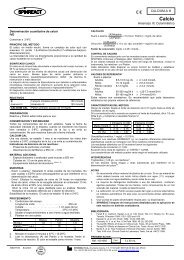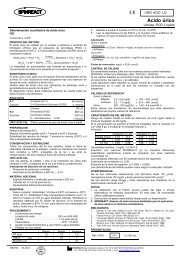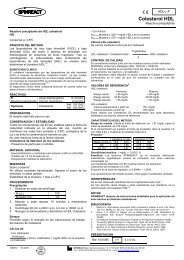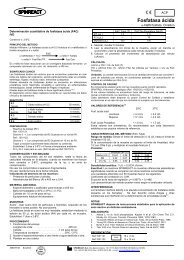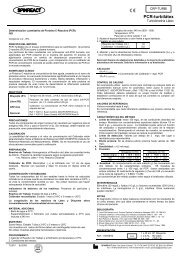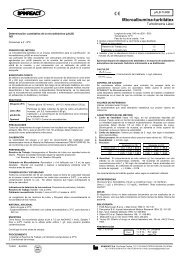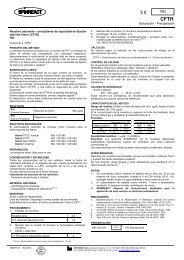RF-turbilatex - IDCCA
RF-turbilatex - IDCCA
RF-turbilatex - IDCCA
Create successful ePaper yourself
Turn your PDF publications into a flip-book with our unique Google optimized e-Paper software.
Quantitative determination of Rheumatoid Factors (<strong>RF</strong>)<br />
IVD<br />
Store 2 - 8ºC.<br />
PRINCIPLE OF THE METHOD<br />
The <strong>RF</strong>-Turbilatex is a quantitative turbidimetric test for the measurement of <strong>RF</strong> in human<br />
serum or plasma.<br />
Latex particles coated with human gammaglobulin are agglutinated when mixed with<br />
samples containing <strong>RF</strong>. The agglutination causes an absorbance change, dependent upon<br />
the <strong>RF</strong> contents of sample that can be quantified by comparison from a calibrator of known<br />
<strong>RF</strong> concentration.<br />
CLINICAL SIGNIFICANCE<br />
Rheumatoid factors are a group of antibodies directed to determinants in the Fc portion of<br />
the immunoglobulin G molecule. Although rheumatoid factors are found in a number of<br />
rheumatoid disorders, such as systemic lupus erythematosus (SLE) and Sjögren’s<br />
syndrome, as well as in nonrheumatic conditions, its central role in clinic lies its utility as an<br />
aid in the diagnosis of rheumatoid arthritis (RA).<br />
A study of the “American College of Rheumatology” shows that the 80.4% of RA patients<br />
were <strong>RF</strong> positive.<br />
REAGENTS<br />
Diluent (R1) Tris buffer 20 mmol/L, pH 8.2. Sodium azide 0.95 g/L.<br />
Latex (R2)<br />
<strong>RF</strong>-CAL<br />
Optional<br />
Latex particles coated with human gammaglobulin, pH 7.4. Sodium<br />
azide 0.95 g/L.<br />
Calibrator. Human serum. The <strong>RF</strong> concentration is stated on the vial<br />
label.<br />
Ref.:1102114 Control serum ASO/CRP/<strong>RF</strong> Level L<br />
Ref.:1102115 Control serum ASO/CRP/<strong>RF</strong> Level H.<br />
PRECAUTIONS<br />
Components from human origin have been tested and found to be negative for the<br />
presence of HBsAg, HCV, and antibody to HIV (1/2). However handle cautiously as<br />
potentially infectious.<br />
CALIBRATION<br />
The sensitivity of the assay and the target value of the calibrator have been standardized<br />
against the International Reference NIBSC 64/2 (Rheumatoid Arthritis Serum) WHO. It is<br />
not recommended the use of other commercially available <strong>RF</strong> calibrators.<br />
PREPARATION<br />
<strong>RF</strong> Calibrator: Reconstitute (→) with 2.0 mL of distilled water. Mix gently and bring to<br />
room temperature for about 10 minutes before use.<br />
Calibration Curve (range from 20 to 160 IU/mL): Prepare the following <strong>RF</strong><br />
calibrator dilutions in NaCl 9 g/L. Multiply the concentration of the <strong>RF</strong> calibrator by<br />
the corresponding factor stated in table bellow to obtain the <strong>RF</strong> concentration of<br />
each dilution.<br />
Calibrator dilution 1 2 3 4 5 6<br />
Calibrator <strong>RF</strong> (µL) -- 10 25 50 75 100<br />
NaCl 9 g/L (µL) 100 90 75 50 25 -<br />
Factor 0 0.1 0.25 0.5 0.75 1.0<br />
One point calibration (lineal range up to 100 IU/mL): Prepare a <strong>RF</strong> Calibrator dilution:<br />
- 30 µL <strong>RF</strong> Calibrator + 70 µL NaCl 9 g/L<br />
Multiply the <strong>RF</strong> calibrator concentration by 0.30 to obtain the <strong>RF</strong> concentration of the<br />
diluted calibrator.<br />
STORAGE AND STABILITY<br />
All the components of the kit are stable until the expiration date on the label when<br />
stored tightly closed at 2-8ºC and contaminations are prevented during their use. Do<br />
not use reagents over the expiration date.<br />
Reagent deterioration: Presence of particles and turbidity.<br />
Reconstituted calibrator: Stable for 1 month at 2-8ºC or 3 months at –20ºC.<br />
Do not freeze; frozen latex and diluent could change the functionality of the test.<br />
ADDITIONAL EQUIPMENT<br />
- Thermostatic bath at 37ºC.<br />
- Spectrophotometer or photometer thermostatable at 37ºC with a 650 nm filter (600<br />
– 650 nm).<br />
SAMPLES<br />
Fresh serum or plasma. Stable 7 days at 2-8ºC or 3 months at –20ºC.<br />
The samples with presence of fibrin should be centrifuged before testing.<br />
Do not use highly hemolized or lipemic samples.<br />
PROCEDURE<br />
1. Bring the reagents and the photometer (cuvette holder) to 37ºC.<br />
2. Assay conditions:<br />
Wavelength : 650 nm (600-650 nm)<br />
Temperature : 37 ºC<br />
Cuvette ligth path : 1cm<br />
3. Adjust the instrument to zero with distilled water.<br />
4. Pipette into a cuvette:<br />
<strong>RF</strong>-TURBI<br />
<strong>RF</strong>-<strong>turbilatex</strong><br />
Latex turbidimetry<br />
Blank Calibrator /Sample<br />
NaCl 9 g/L (µL) 7 --<br />
Calibrator or sample (µL) -- 7<br />
R1: Diluent (mL) 0.9 0.9<br />
R2. Latex (mL) 0.1 0.1<br />
6. Mix and read the absorbance after 2 minutes (A2) of the sample addition.<br />
SPINREACT has instruction sheets for several automatic analyzers.<br />
Instructions for many of them are available on request.<br />
CALCULATIONS<br />
Calibration curve (Note 1): Calculate the absorbance difference<br />
(A2-Ablank reagent) of each point of the calibration curve and plot the values obtained<br />
against the <strong>RF</strong> concentration of each calibrator dilution. Rheumatoid factor<br />
concentration in the sample is calculated by interpolation of its (A2-Ablank reagent)<br />
in the calibration curve.<br />
One point calibration:<br />
(A2-Ablank reagent) sample<br />
(A2-Ablank reagent) calibrator<br />
x Diluted calibrator concentration = IU/mL <strong>RF</strong><br />
QUALITY CONTROL<br />
Control Sera are recommended to monitor the performance of manual and<br />
automated assay procedures. It should be used SPINREACT Control<br />
ASO/CRP/<strong>RF</strong> Level L (Ref.: 1102114) and Level H (Ref.: 1102115).<br />
Each laboratory should establish its own Quality Control scheme and corrective<br />
actions if controls do not meet the acceptable tolerances.<br />
REFERENCE VALUES<br />
Normal values up to 20 IU/mL. Each laboratory should establish its own<br />
reference range.<br />
PE<strong>RF</strong>ORMANCE CHARACTERISTICS<br />
1. Linearity (one point calibration): Up to 100 IU/mL, under the described assay<br />
conditions.<br />
2. Limit detection: Values less than 6 IU/mL give non-reproducible results.<br />
3. Measurement range (calibration curve): 6-160 IU/mL, under the described<br />
assay conditions. Samples with higher concentrations should be diluted 1/5 in<br />
NaCl 9 g/L and retested again. The linearity limit and measurement range<br />
depends on the sample to reagent/ratio, as well as the analyzer used. It will be<br />
higher by decreasing the sample volume, although the sensitivity of the test<br />
will be proportionally decreased.<br />
4. Prozone effect: No prozone effect was detected upon 800 IU/mL.<br />
5. Sensitivity: ∆ 3.34 mA. IU/mL.<br />
6. Precision:<br />
Intra-assay (n=10) Inter-assay (n=10)<br />
Mean (IU/mL) 14.9 45.8 14.9 45.8<br />
SD 0.96 1.32 1.2 2.54<br />
CV 6.5 2.9 8.0 5.6<br />
7.Accuracy: Results obtained using this reagent (y) were compared to those<br />
obtained using a commercial reagent (x) with similar characteristics. 86<br />
samples ranging from 1 to 160 IU/mL of <strong>RF</strong> were assayed. The correlation<br />
coefficient (r) was 0.95 and the regression equation y = 0.797x -1.075.<br />
The results of the performance characteristics depend on the analyzer used.<br />
INTE<strong>RF</strong>ERENCES<br />
Hemoglobin (10 g/L), bilirrubin (20 mg/dL) and lipemia (10 g/L), do not interfere.<br />
Other substances may interfere 6 .<br />
NOTES<br />
1. Multipoint calibration gives more accurate results than one point calibration.<br />
2. Clinical diagnosis should not be made on findings of a single test result, but<br />
should integrate both clinical and laboratory data.<br />
BIBLIOGRAPHY<br />
1. Frederick Wolfe et al. Arthritis and Rheumatism 1991; 34: 951- 960.<br />
2. Robert W Dorner et al. Clinica Chimica Acta 1987; 167: 1-21.<br />
3. Robert H Shmerling et al. The American Journal of Medicine 1991; 91: 528 – 534.<br />
4. Vladimir Muié et al. Scand J Rheumatology 1972; 1: 181 – 187.<br />
5. Paul R et al. Clin Chem 1979; 25/11: 1909 – 1914.<br />
6. Young DS. Effects of drugs on clinical laboratory test, 4th ed. AACC Press, 1995.<br />
PACKAGING<br />
Ref.: 1107005 N : 1 x 45 mL R1. Diluent<br />
Cont.<br />
:1 x 5 mL R2. Latex<br />
:1 x 2 mL <strong>RF</strong>-CAL<br />
TLIS02 Ed.2005 SPINREACT,S.A. Ctra.Santa Coloma, 7 E-17176 SANT ESTEVE DE BAS (GI) SPAIN<br />
Tel. +34 972 69 08 00 Fax +34 972 69 00 99 e-mail: spinreact@spinreact.com
Determinación cuantitativa de Factores Reumatoides (FR)<br />
IVD<br />
Conservar a 2- 8ºC.<br />
PRINCIPIO DEL MÉTODO<br />
El FR-Turbilátex es un ensayo turbidimétrico para la cuantificación de factores<br />
reumatoides (FR) en suero o plasma humano.<br />
Las partículas de látex recubiertas con gammaglobulina humana, son aglutinadas por FR<br />
presentes en la muestra del paciente. El proceso de aglutinación provoca un cambio de<br />
absorbancia proporcional a la concentración de FR de la muestra, y por comparación con<br />
un calibrador de FR de concentración conocida se puede determinar el contenido de FR<br />
en la muestra ensayada.<br />
SIGNIFICADO CLÍNICO<br />
Los factores reumatoides son un grupo de anticuerpos dirigidos contra la fracción Fc de<br />
las inmunoglobulinas G. Aunque se hallan presentes en un gran número de desordenes<br />
reumáticos, tales como el lupus eritematoso sistémico (SLE) y el síndrome de Sjögren, su<br />
principal interés clínico radica en el diagnóstico de la artritis reumatoide (RA). Un estudio<br />
actual realizado por el “American College of Rheumatolgy” demostró que el 80,4% de<br />
pacientes con artritis reumatoide fueron positivos para el FR.<br />
REACTIVOS<br />
Diluyente (R1) Tampón tris 20 mmol/L, pH, 8,2 . Azida sódica 0,95.<br />
Látex (R2)<br />
<strong>RF</strong>-CAL<br />
Opcional:<br />
Partículas de látex recubiertas de gammaglobulina humana,<br />
pH, 7,4. Azida sódica 0,95 g/L.<br />
Calibrador. Suero humano. La concentración de FR viene<br />
indicada en la etiqueta del vial.<br />
Ref: 1102114 Suero Control ASO/PCR/FR Nivel L.<br />
Ref: 1102115 Suero Control ASO/PCR/FR Nivel H.<br />
PRECAUCIONES<br />
Todos los componentes de origen humano han resultado ser negativos para el antígeno<br />
HBs, HCV, y para el anti-HIV (1/2). Sin embargo, deben tratarse con precaución como<br />
potencialmente infecciosos.<br />
CALIBRACIÓN<br />
La sensibilidad del ensayo y el valor de concentración del Calibrador están estandarizados<br />
frente el Patrón Internacional de FR de OMS (WHO 64/2 Rheumatoid Arthritis Serum).<br />
No se recomienda para la calibración el uso de otros calibradores de FR comerciales.<br />
PREPARACIÓN<br />
Calibrador FR: Reconstituir (→) el liofilizado con 2,0 mL de agua destilada. Mezclar con<br />
suavidad y reposar a temperatura ambiente unos 10 minutos antes de usarlo.<br />
Curva de Calibración (rango de 20 a 160 UI/mL): Preparar las siguientes diluciones del<br />
Calibrador de FR en ClNa 9 g/L como diluyente. Para obtener las concentraciones de cada<br />
dilución de FR, multiplicar la concentración del Calibrador por el factor correspondiente<br />
indicado en la tabla:<br />
Dilución calibrador 1 2 3 4 5 6<br />
Calibrador FR (µL) -- 10 25 50 75 100<br />
ClNa 9 g/L (µL) 100 90 75 50 25 -<br />
Factor 0 0.1 0,25 0,5 0,75 1,0<br />
Calibración a un solo punto (rango lineal hasta 100 UI/mL): Preparar una dilución del<br />
Calibrador de FR:<br />
30 µL Calibrador de FR + 70 µL ClNa 9 g/L<br />
La concentración de FR de la dilución se calcula multiplicando la concentración del<br />
Calibrador de FR por 0,30.<br />
CONSERVACIÓN Y ESTABILIDAD<br />
Todos los componentes del kit son estables hasta la fecha de caducidad cuando se<br />
mantienen los viales bien cerrados a 2-8ºC, y se evita la contaminación durante su uso. No<br />
utilizar reactivos que hayan sobrepasado la fecha de caducidad.<br />
La congelación de los reactivos de Látex y Diluyente altera irreversiblemente la<br />
funcionalidad de éstos.<br />
Indicadores de deterioro de los reactivos: Presencia de partículas y turbidez.<br />
Calibrador reconstituido: Estable 1 mes a 2-8ºC o 3 meses a –20ºC.<br />
MATERIAL ADICIONAL<br />
- Baño de agua a 37ºC.<br />
- Espectrofotómetro o fotómetro con cubeta termostatizable a 37ºC para lecturas a 650 nm<br />
(600-650 nm).<br />
MUESTRAS<br />
Suero fresco. Estable 7 días a 2-8ºC o 3 meses a -20ºC.<br />
Las muestras con restos de fibrina deben ser centrifugadas para su eliminación.<br />
No utilizar muestras altamente hemolizadas o lipémicas.<br />
PROCEDIMIENTO<br />
1. Calentar los reactivos y el fotómetro (portacubetas) a 37ºC.<br />
2. Condiciones del ensayo:<br />
Longitud de onda: 650 nm (600 –650 nm)<br />
Temperatura: 37ºC<br />
Paso de luz de la cubeta: 1 cm<br />
3. Ajustar el espectrofotómetro a cero frente a agua destilada.<br />
<strong>RF</strong>-TURBI<br />
FR-turbilátex<br />
Turbidimetría Látex<br />
4. Pipetear en una cubeta:<br />
Blanco Muestra/Calibrador<br />
ClNa 9 g/L (µL) 7 --<br />
Calibrador o muestra (µL) -- 7<br />
R.1 Diluyente (mL) 0,9 0,9<br />
R.2 Látex (mL) 0,1 0,1<br />
5. Mezclar y leer la absorbancia a los 2 minutos (A2) de efectuada la mezcla.<br />
SPINREACT dispone de adaptaciones detalladas a la mayoría de analizadores<br />
automáticos del mercado. Solicite la información a su distribuidor.<br />
CÁLCULOS<br />
Con curva de calibración (Nota 1): Calcular la diferencia de absorbancias (A2 –<br />
ABlanco) obtenidas para los distintos calibradores, y construir la curva de<br />
calibración de los valores obtenidos frente a las concentraciones de FR de cada<br />
dilución del Calibrador. La concentración de factores reumatoides en la muestra<br />
se calcula por interpolación de su diferencia (A2– ABlanco ) en la curva de<br />
calibración.<br />
Calibración a un solo punto:<br />
(A2 - ABlanco) muestra<br />
(A2 - ABlanco)calibrador<br />
x Concentración del Calibrador FR diluido = UI/mL FR<br />
CONTROL DE CALIDAD<br />
Se recomienda utilizar sueros control para controlar los ensayos tanto en<br />
procedimiento manual como en automático. Spinreact dispone de sueros control<br />
ASO/PCR/FR nivel L (Ref: 1102114) y nivel H (Ref: 1102115).<br />
Cada laboratorio debería establecer su propio Control de Calidad y establecer<br />
correcciones en el caso de que los controles no cumplan con las tolerancias exigidas.<br />
VALORES DE REFERENCIA<br />
Valores normales hasta 20 UI/mL. Es recomendable que cada laboratorio establezca<br />
sus propios valores de referencia.<br />
CARACTERÍSTICAS DEL MÉTODO<br />
1. Límite de linealidad (para calibración a un solo punto): hasta 100 UI/mL, en<br />
las condiciones descritas del ensayo.<br />
2. Límite de detección: valores por debajo de 6 UI/mL dan lugar a resultados<br />
poco reproducibles.<br />
3. Rango de medida (para curva de calibración): 6-160 UI/mL, en las<br />
condiciones descritas del ensayo. Puede variar en función del analizador o<br />
espectrofotómetro utilizado. Las muestras con valores superiores deben<br />
diluirse 1/5 en ClNa 9 g/L y ensayarse de nuevo. La linealidad y el rango de<br />
medida dependen de la relación muestra/reactivo. Disminuyendo el volumen<br />
de muestra, se aumenta el límite superior de linealidad, aunque se reduce la<br />
sensibilidad.<br />
4. Sensibilidad: ∆ 3,34 mA. UI/mL.<br />
5. Efecto prozona: No se observa efecto prozona hasta valores de 800 UI/mL.<br />
6. Precisión:<br />
Intraserie (n=10) Interserie (n=10)<br />
Media (UI/mL) 14,9 45,8 14,9 45,8<br />
SD 0,96 1,32 1,2 2,54<br />
CV 6,5 2,9 8.0 5,6<br />
7. Exactitud: El comportamiento de este método (y) fue comparado con otro<br />
método (x) de características similares. 86 muestras de concentraciones de<br />
FR entre 1 y 160 UI/mL fueron analizadas con ambos métodos. El coeficiente<br />
de correlación (r) fue de 0,95 y la ecuación de la recta de regresión y =<br />
0,797x – 1,075<br />
Las características del método pueden variar según el analizador utilizado.<br />
INTE<strong>RF</strong>ERENCIAS<br />
Bilirrubina (20 mg/dL), hemoglobina (10 g/L) y lípidos (10 g/L), no interfieren. Otras<br />
sustancias pueden interferir 6 .<br />
NOTAS<br />
1. La calibración multipunto da resultados más exactos que el método de calibración<br />
a un solo punto.<br />
2. El diagnóstico clínico no debe realizarse únicamente con los resultados de un<br />
único ensayo, sino que debe considerarse al mismo tiempo los datos clínicos del<br />
paciente.<br />
BIBLIOGRAFÍA<br />
1. Frederick Wolfe et al. Arthritis and Rheumatism 1991; 34: 951- 960.<br />
2. Robert W Dorner et al. Clinica Chimica Acta 1987; 167: 1-21.<br />
3. Robert H Shmerling et al. The American Journal of Medicine 1991; 91: 528 – 534.<br />
4. Vladimir Muié et al. Scand J Rheumatology 1972; 1: 181 – 187.<br />
5. Paul R et al. Clin Chem; 1979; 25/11: 1909 – 1914.<br />
6. Young DS. Effects of drugs on clinical laboratory test, 4th ed. AACC Press, 1995.<br />
PRESENTACIÓN<br />
Ref.: 1107005N : 1 x 45 mL R1. Diluyente<br />
Cont.<br />
:1 x 5 mL R2. Látex<br />
:1 x 2 mL <strong>RF</strong>-CAL<br />
TLIS02 Ed.2005 SPINREACT,S.A. Ctra.Santa Coloma, 7 E-17176 SANT ESTEVE DE BAS (GI) SPAIN<br />
Tel. +34 972 69 08 00 Fax +34 972 69 00 99 e-mail: spinreact@spinreact.com



